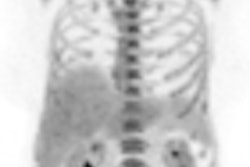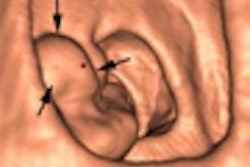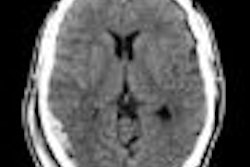VIENNA - Finding how far a patient's cancer has spread is critical in planning and optimizing treatment. Various imaging techniques now provide indispensable tools for staging primary tumors, including PET, CT, and MRI, but a new comparative study found fused whole-body PET/CT to be significantly more accurate than whole-body MRI -- even at 3 tesla -- for primary tumor staging.
Between November 2002 and January 2008, a group of Italian researchers assessed the quality of whole-body FDG-PET/CT images versus images from CT alone, CT+PET images viewed side by side, and whole-body 3-tesla MR images. They presented the results of their research Monday at the 2008 European Congress of Radiology (ECR).
"The aim of the study was to determine the potential benefits concerning patient management when staging primary tumors -- that is, the diagnostic advantages and impact on treatment," said Dr. Stefano Mancino of Tor Vergata University in Rome.
The patients in the study had a variety of malignant diseases, including five cases of breast cancer, four lung cancers, three liver carcinomas, two melanomas, and six lymphomas.
The researchers obtained CT and PET/CT images of the patients using a PET/CT scanner (Discovery ST, GE Healthcare, Chalfont St. Giles, U.K.) with an acquisition time of approximately 30 minutes, while the MRI images were acquired on a 3-tesla machine (Achieva 3.0T, Philips Healthcare, Andover, MA) using a body coil and an unlimited field-of-view.
Results showed a superior diagnostic performance from fused PET/CT imaging, which was significantly more accurate in assessing overall tumor, node, metastases (TNM) staging versus standalone CT (p < 0.05), side-by-side CT+PET (p < 0.05), and whole-body MRI.
Of the 20 patients in the study, PET/CT correctly staged 16 (80%), side-by-side CT+PET was accurate in 14 (70%) cases, and CT imaging alone identified 13 (65%) cancers, while 3-tesla MRI correctly staged tumors in 12 (60%) patients. The clear diagnostic advantages as highlighted in this study were translated into changes and improvements in the clinical management of several patients, Mancino said.
"Our qualitative analysis demonstrated that whole-body fused PET/CT versus whole-body MRI had a clinical superiority in these 20 patients, and had an impact on treatment, leading to changes in one patient compared with CT+PET side by side and CT alone, and in two patients compared with MRI," Mancino said.
There was discordance between PET/CT and MRI results when identifying small lesions in the left liver segment and depicting metastases. PET/CT and side-by-side CT+PET were more sensitive in depicting small bone lesions and pulmonary lesions than CT alone, Mancino noted.
In specifically assessing metastases (M staging), any differences in the relative performance of PET/CT and CT+PET viewed side by side were not statistically significant, he said.
Mancino acknowledged whole-body MRI to be an effective tool for staging cancer patients but added, that based on his team's experience, "it cannot reach the accuracy of fused FDG-PET/CT images."
"Whole-body fused PET/CT is significantly more accurate than CT alone and CT+PET side by side in staging malignant disease," he concluded.
Finding bone metastases
In related work, Dr. Till Heusner from the University of Duisburg-Essen in Germany compared whole-body MRI and whole-body FDG-PET/CT in detecting bone metastases at initial diagnosis in patients with malignant melanoma and non-small cell lung cancer (NSCLC)
Both imaging procedures were performed within a 14-day time period, with a mean interval of 0.6 days. Differences between the imaging procedures were tested for significance using McNemar's test (p < 0.05).
Based on the standard reference that three patients with malignant melanoma and eight with NSCLC had bone metastases (of the total 109-patient study group), results showed that FDG-PET/CT correctly detected bone metastases in five patients, while MRI did the same in seven patients.
Each of the five metastases discovered using PET/CT imaging were in the NSCLC group; MRI also found five in this group, plus two in the melanoma group.
However, both imaging modalities had false-positive results: MRI produced six false positives, while PET/CT produced one false-positive result.
While admitting that the results from this relatively small study would benefit from verification in a larger test, Heusner concluded that whole-body FDG-PET/CT and whole-body MRI were similarly accurate in assessing patients at initial diagnosis of malignant melanoma and NSCLC.
"MRI was more sensitive but less specific than FDG-PET/CT; however, a substantial number of false-negative findings from whole-body MRI and whole-body fused PET/CT requires a close-follow up of M-0 stage patients," he said.
By Rob Skelding
AuntMinnie.com contributing writer
March 10, 2008
Related Reading
FDG-PET/CT aids in radiation therapy planning, March 5, 2008
PET/CT moves closer to diagnostic standard of care, March 1, 2008
False positives a concern with FDG-PET/CT for head, neck tumors, January 31, 2008
PET/CT shows its worth in cervical carcinoma, January 18, 2008
FDG-PET/CT accurately detects inflammatory breast cancer, November 27, 2007, November 27, 2007
Copyright © 2008 AuntMinnie.com



















